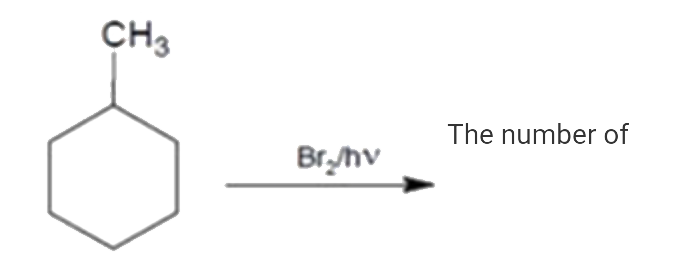The numberof all possible products excluding stereoisomers obtained on monochlorination of n-butane and iso-butane are respectively
2 and 3
3 and 2
2 and 1
2 and 2
The correct Answer is:D
To solve the question regarding the number of possible products (excluding stereoisomers) obtained from the monochlorination of n-butane and isobutane, we will follow these steps:
Step 1: Understand the Structures of n-Butane and Isobutane
- n-Butane: The structure is CH3-CH2-CH2-CH3.
- Isobutane: The structure is (CH3)2CH-CH3.
Step 2: Identify the Types of Hydrogens in n-Butane
- In n-butane, we can identify:
- 3 terminal CH3 groups (each has 3 equivalent hydrogens).
- 2 CH2 groups (each has 2 equivalent hydrogens).
Therefore, we have:
- 3 equivalent hydrogens from the terminal CH3.
- 4 equivalent hydrogens from the two CH2 groups (2 from each).
Step 3: Count the Unique Types of Hydrogens in n-Butane
- The unique types of hydrogens in n-butane are:
- 3 from CH3 (terminal)
- 2 from CH2 (middle)
Thus, there are 2 unique types of hydrogens in n-butane.
Step 4: Determine the Number of Monochlorination Products for n-Butane
- Each unique hydrogen can be replaced by a chlorine atom, leading to different products:
- Replacing one of the terminal CH3 hydrogens gives one product.
- Replacing one of the CH2 hydrogens gives another product.
Therefore, the total number of products from n-butane is 2.
Step 5: Identify the Types of Hydrogens in Isobutane
- In isobutane, we can identify:
- 3 equivalent hydrogens from the two terminal CH3 groups.
- 1 hydrogen from the central carbon (CH).
Step 6: Count the Unique Types of Hydrogens in Isobutane
- The unique types of hydrogens in isobutane are:
- 3 from the terminal CH3 groups (equivalent).
- 1 from the central CH.
Thus, there are 2 unique types of hydrogens in isobutane.
Step 7: Determine the Number of Monochlorination Products for Isobutane
- Each unique hydrogen can be replaced by a chlorine atom:
- Replacing one of the terminal CH3 hydrogens gives one product.
- Replacing the central CH hydrogen gives another product.
Therefore, the total number of products from isobutane is 2.
Final Answer
The number of possible products excluding stereoisomers obtained on monochlorination of n-butane and isobutane are respectively 2 and 2.
- n-Butane: The structure is CH3-CH2-CH2-CH3.
- Isobutane: The structure is (CH3)2CH-CH3.
- In n-butane, we can identify:
- 3 terminal CH3 groups (each has 3 equivalent hydrogens).
- 2 CH2 groups (each has 2 equivalent hydrogens).
Therefore, we have:
- 3 equivalent hydrogens from the terminal CH3.
- 4 equivalent hydrogens from the two CH2 groups (2 from each).
- The unique types of hydrogens in n-butane are:
- 3 from CH3 (terminal)
- 2 from CH2 (middle)
Thus, there are 2 unique types of hydrogens in n-butane.
- Each unique hydrogen can be replaced by a chlorine atom, leading to different products:
- Replacing one of the terminal CH3 hydrogens gives one product.
- Replacing one of the CH2 hydrogens gives another product.
Therefore, the total number of products from n-butane is 2.
- In isobutane, we can identify:
- 3 equivalent hydrogens from the two terminal CH3 groups.
- 1 hydrogen from the central carbon (CH).
- The unique types of hydrogens in isobutane are:
- 3 from the terminal CH3 groups (equivalent).
- 1 from the central CH.
- Each unique hydrogen can be replaced by a chlorine atom:
- Replacing one of the terminal CH3 hydrogens gives one product.
- Replacing the central CH hydrogen gives another product.
Therefore, the total number of products from isobutane is 2.
The number of possible products excluding stereoisomers obtained on monochlorination of n-butane and isobutane are respectively 2 and 2.
Topper's Solved these Questions
Similar Questions
Knowledge Check
The number of possible enantiomeric pairs that can be produced during monochlorination of 2-methyl butane is :
A3B4C2D1The number of all the possible stereoisomers formed by the given compound is :
 A2B3C32D64
A2B3C32D64
 The number of possible mono bromo products are (excluding stereo isomers)
The number of possible mono bromo products are (excluding stereo isomers)
View SolutionMost stable conformation of n-butane is :
View SolutionThe number of possible isomers (including stereoisomers) on monochlorination (Cl2/hv) of the following compound is:

View SolutionThe least stable conformation of n-butane is
View SolutionThe number of possibel enantiomeric pairs that can be produced during monochlorination of 2-methyl butane is :
View SolutionHow would you convert n-butane to iso-butane?
View Solution
